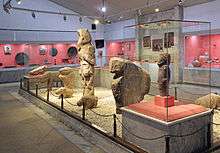Şanlıurfa Archaeology and Mosaic Museum
Şanlıurfa Archaeology and Mosaic Museum is a museum in Şanlıurfa (also known as Urfa), Turkey. The museum contains remains of Şanlıurfa (known as Edessa in antiquity), Harran (another ancient city which lies 44 kilometres (27 mi) southeast of Şanlıurfa), and ruins found in the hydroelectric dam reservoirs of Atatürk Dam, Birecik Dam and Karkamış Dam.
Şanlıurfa Arkeoloji ve Mozaik Müzesi | |
 From Göbeklitepe excavations | |
 Şanlıurfa Museum | |
| Established | 2015 |
|---|---|
| Location | Haleplibahçe caddesi, Şanlıurfa, Turkey |
| Coordinates | 37°09′13″N 38°46′54″E |
| Type | Archaeology, Mosaic, Ethnography |
| Collections | Neolithic, Chalcolithic Bronze Age Hittite Assyria, Babylonia |
| Owner | Ministry of Culture and Tourism |
The location history and the building
The museum is on Haleplibahçe street, close to Balıklıgöl, a sacred pool.[1] The museum opened in 2015, and replaced the former museum of Şanlıurfa on Çamlık street. With a closed area of 34,000 square metres (370,000 sq ft), it is one of the biggest museums of in Turkey.[2] The museum consists of two major sections. To the north is the mosaic section and to the south is the archaeology section which is a three-storey building. In addition to exhibition halls there are offices, a museum lab, a library, restaurants, markets and a playground for kids.
The mosaic section
The mosaic of Orpheus was created in 184 A.D. in Edessa. It was found in 1980, and was taken to United States by illegal means. After some handovers, it returned to Şanlıurfa from the Dallas Museum in 2015.[3]
The archaeology section
In the ground and upper floor there are four exhibition halls. The first exhibition hall is reserved for Assyrian, Babylonian and Hittite artifacts. In the second and third halls, Neolithic, Chalcolithic and Bronze Age items such as stone tools, terracota ceramic tools, stamps, pithoi, necklaces, figurines, metallic tools, ornaments, and idols are exhibited.[4] One of the most important items is a 9500-year-old sculpture which is the oldest-known life-size human sculpture.[2] In the ethnographic section, clothes, silver and bronze ornaments, handworks, doors with epitaph, examples of calligraphy, and hand written Korans are exhibited. In the yard, there are various archaeologic items.[4]
References
- Erman Ertuğrul (25 May 2015). "Urfa'da Haleplibahçe Müze Kompleksi Açıldı". Arkeofili (in Turkish). Retrieved 18 March 2017.
- "ŞANLIURFA ARKEOLOJİ MÜZESİ". www.aktuelarkeoloji.com.tr (in Turkish). Retrieved 18 March 2017.
- "Edessa Mozaikleri | Arkeolojihaber". arkeolojihaber.net (in Turkish). Retrieved 18 March 2017.
- "Şanlıurfa Arkeoloji ve Mozaik Müzesi - Müze". www.muze.gov.tr (in Turkish). Retrieved 18 March 2017.
External links
